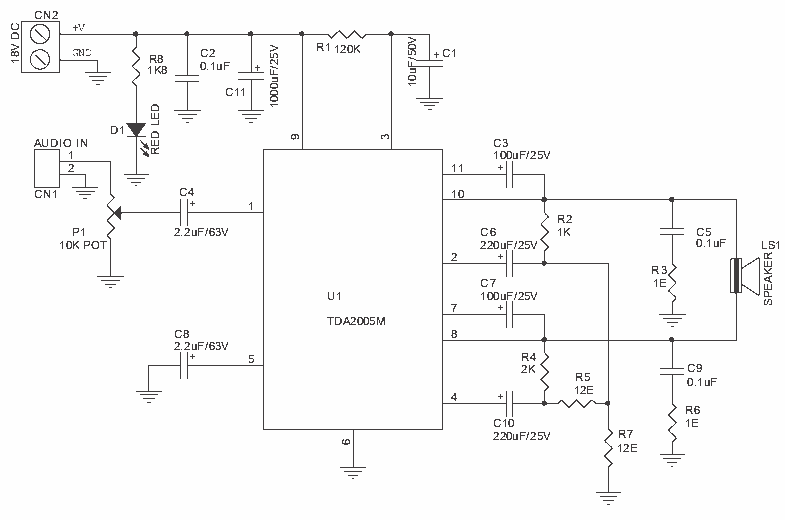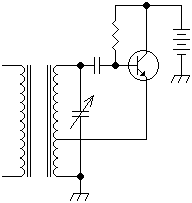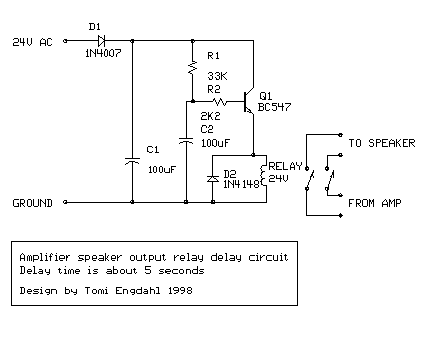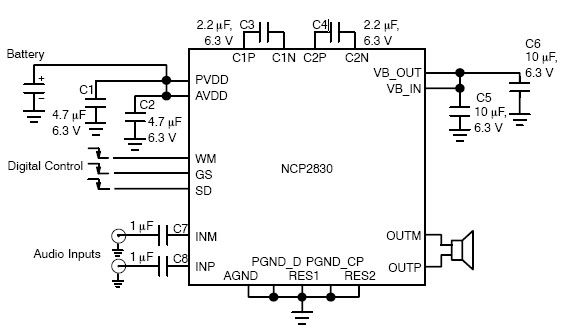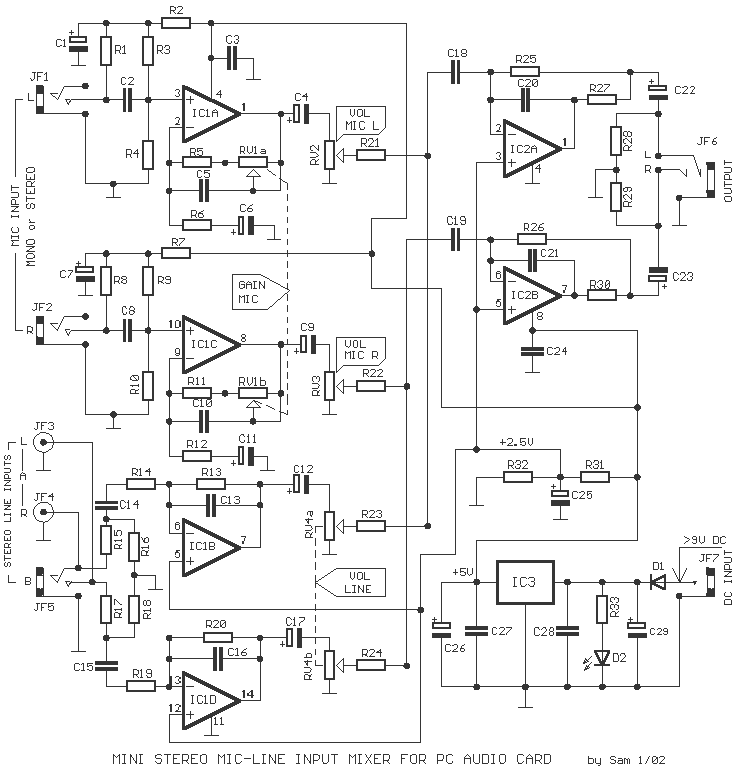
Twin-T Audio Sine Wave Oscillator
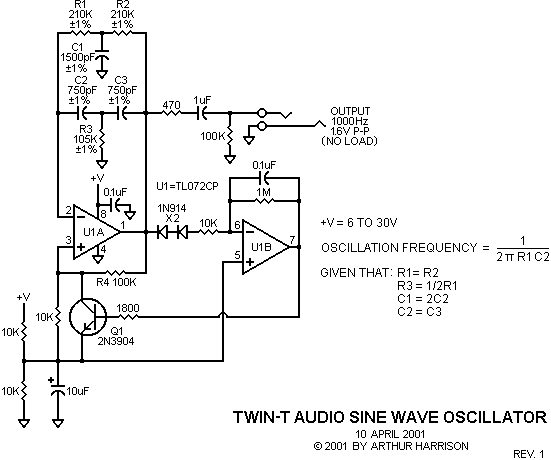
The circuit produces a clean sine wave signal suitable for audio testing or other applications requiring a high-quality sine voltage source. It utilizes a widely available dual operational amplifier, the Texas Instruments TL072CP. The component values yield an output frequency of approximately 1000 Hertz, which can be adjusted over a broad range using the equation provided in the schematic. The frequency is primarily determined by the twin-T network in the feedback loop of U1A, assuming the op-amp's gain-bandwidth product and slew rate specifications are sufficiently high. For frequencies above 10kHz, a faster op-amp is recommended in the U1A position. The oscillator's frequency-selective twin-T network comprises components C1, C2, C3, R1, R2, and R3, which are integrated into the negative feedback path of the operational amplifier. The positive-input to output transfer function of U1A acts as a notch filter with a frequency and depth defined by the values of these components, exhibiting zero degrees of phase shift at the notch frequency. The characteristics of the twin-T network are governed by specific equations. Positive feedback necessary for oscillation is supplied by R4. Transistor Q1 forms part of an automatic gain control (AGC) servo that maintains a consistent amplitude of the sine wave output by regulating the positive feedback of U1A. The circuit oscillates at the notch frequency when the emitter-to-collector resistance (Rec) of Q1 is appropriately set. U1B and its associated components complete the AGC function. The series-connected diodes provide negative peak-level detection of the sine wave voltage and influence the output amplitude. Q1 operates near maximum conduction, ensuring minimal distortion to the sine wave from its emitter to collector voltage. The 0.1µF integrating capacitor in the feedback path of U1B was selected to ensure stability of the AGC loop at the chosen oscillation frequency. A 10K resistor in parallel with Q1 aids in the start-up process. The precision of the resistor and capacitor ratios in the twin-T network is critical for ensuring oscillation at the desired frequency, thus ±1% tolerance components are recommended. R1, R2, and R3 should be metal film resistors, while C1, C2, and C3 should ideally be C0G ceramic or mica capacitors (preferred), or polystyrene capacitors (acceptable). For larger values of C1, C2, and C3, polyester capacitors may be used for cost-effectiveness. A capacitor ratio of 2:1 can be efficiently achieved with standard values that maintain this relationship, such as 750pF and 1500pF, 1000pF and 2000pF, 1100pF and 2200pF, 1500pF and 3000pF, or 1800pF and 3600pF. Alternatively, four equivalent capacitors can be utilized, with two paralleled to form C1. This method can also be applied to the three resistors, particularly when an exact 2:1 ratio is not available. Notably, the emitter and collector of Q1 can be interchanged without significantly affecting circuit performance, although conventionally the emitter is biased negatively concerning the base. If the two diodes are reversed, Q1 can be substituted with a PNP transistor, such as the 2N3906. The oscillator's amplitude and frequency are largely independent of the power supply voltage, with an output amplitude of 1.6 volts peak-to-peak selected to accommodate power supply voltages as low as 6 volts. Substituting the TL072CP with a rail-to-rail dual operational amplifier, such as the Analog Devices AD823AN, allows operation from even lower supply voltages, such as 4 volts. The oscillator can effectively operate from a single 9-volt battery and consumes less than 5 milliamperes of current when using the TL072CP. A 470-ohm resistor at the output mitigates instabilities caused by capacitive loads, such as long cables, while a 1µF capacitor eliminates the DC offset at U1A. The output's 100K resistor discharges the 1µF capacitor to prevent voltage transients.
The circuit design is centered around the use of the TL072CP operational amplifier, which is favored for its low noise and high performance in audio applications. The twin-T network configuration is specifically chosen for its ability to produce a stable sine wave output, which is vital for testing audio equipment. The design emphasizes the importance of component selection; using resistors and capacitors with tight tolerances ensures that the oscillation frequency remains stable and accurate. The inclusion of the automatic gain control circuit enhances the usability of the oscillator by preventing amplitude fluctuations that could affect testing results. This design can be adapted for various applications by adjusting component values, allowing for flexibility in output frequency and amplitude. The circuit's low power consumption and ability to operate from a single battery make it suitable for portable applications, providing convenience without sacrificing performance. Overall, this sine wave oscillator circuit represents a robust solution for generating high-quality sine wave signals for audio testing and other applications.The circuit illustrated produces a clean sine wave signal ideal for audio testing, or wherever a good-quality sine voltage source is required. It uses one integrated circuit which is a widely-available dual operational amplifier, the Texas Instruments TL072CP.
The values shown provide an output frequency of about 1000 Hertz. This frequency may be varied over a wide range, using the equation shown in the schematic. Frequency is almost exclusively determined by the twin-T network in U1A`s feedback loop, provided that the gain-bandwidth product and slew rate specifications for the op amp are sufficiently high. For frequencies exceeding 10kHz, an faster op-amp in the U1A position is recommended. The oscillator`s frequency-selective twin-T network, C1, C2, C3, R1, R2, and R3, is in the negative feedback path of the operational amplifier.
U1A`s positive-input to output transfer function is a notch filter with a frequency and depth determined by those components` values, with zero degrees of phase shift at the notch frequency. The twin-T network characteristics are defined by these equations: The positive feedback required for oscillation is provided by R4.
Transistor Q1 is part of an automatic gain control (AGC) servo that regulates U1A`s positive feedback to keep the sine wave output at a consistent amplitude. The circuit will oscillate at the notch frequency when Q1`s emitter-to-collector resistance (Rec) is: U1B and its associated components complete the servo.
The series-connected diodes provide negative peak-level detection of the sine wave voltage and also determine the amplitude of the output. Q1 is operated close to maximum conduction, so the small voltage from its emitter to collector contributes negligible distortion to the sine wave.
The 0. 1uF integrating capacitor in U1B`s feedback path was chosen to provide adequate AGC-loop stability for the selected oscillation frequency. The 10K resistor in parallel with Q1 provides start-up. The ratios of the resistors and capacitors in the twin-T network must be accurate to ensure oscillation, and at the desired frequency.
For that reason, ±1% components are indicated. R1, R2, and R3 should be metal film, and C1, C2 and C3 should be C0G ceramic or mica (best), or polystyrene (good). Polyester capacitors may be used for economy if large C1, C2, and C3 values, such as those exceeding 10nF, are required.
A capacitor ratio of 2:1 is most conveniently obtained with the standard values that have that nominal relationship, e. g. , 750pF and 1500pF (as shown), 1000pF and 2000pF, 1100pF and 2200pF, 1500pF and 3000pF, and 1800 and 3600pF.
Alternatively, four equivalent capacitors may be used, with two of them paralleled to make C1. The same technique is also applicable for the three resistors, especially when an exact 2:1 ratio of resistance values is not available. Interestingly, Q1`s emitter and collector may be interchanged without any significant effect on the circuit`s performance, although convention dictates that the emitter is biased negatively with respect to the base.
If the two diodes are reversed, then Q1 may be a PNP transistor such as type 2N3906. The oscillator`s amplitude, as well as frequency, is essentially independent of the power supply voltage. An output amplitude of 1. 6 volts peak-to-peak was chosen to accommodate power supply voltages as low as 6 volts. Replacing the TL072CP with a rail-to-rail dual operational amplifier such as the Analog Devices type AD823AN will permit operation from even lower supply voltages, such as 4 volts.
The oscillator will operate conveniently from a single 9-volt battery, and consumes less than 5 milliamperes of current when using the TL072CP. The 470 ohm resistor in the output prevents instabilities from capacitive loads such as long cables, and the 1uF capacitor removes the DC offset at U1A.
The output`s 100K resistor discharges the 1uF capacitor to prevent voltage transien 🔗 External reference
The circuit design is centered around the use of the TL072CP operational amplifier, which is favored for its low noise and high performance in audio applications. The twin-T network configuration is specifically chosen for its ability to produce a stable sine wave output, which is vital for testing audio equipment. The design emphasizes the importance of component selection; using resistors and capacitors with tight tolerances ensures that the oscillation frequency remains stable and accurate. The inclusion of the automatic gain control circuit enhances the usability of the oscillator by preventing amplitude fluctuations that could affect testing results. This design can be adapted for various applications by adjusting component values, allowing for flexibility in output frequency and amplitude. The circuit's low power consumption and ability to operate from a single battery make it suitable for portable applications, providing convenience without sacrificing performance. Overall, this sine wave oscillator circuit represents a robust solution for generating high-quality sine wave signals for audio testing and other applications.The circuit illustrated produces a clean sine wave signal ideal for audio testing, or wherever a good-quality sine voltage source is required. It uses one integrated circuit which is a widely-available dual operational amplifier, the Texas Instruments TL072CP.
The values shown provide an output frequency of about 1000 Hertz. This frequency may be varied over a wide range, using the equation shown in the schematic. Frequency is almost exclusively determined by the twin-T network in U1A`s feedback loop, provided that the gain-bandwidth product and slew rate specifications for the op amp are sufficiently high. For frequencies exceeding 10kHz, an faster op-amp in the U1A position is recommended. The oscillator`s frequency-selective twin-T network, C1, C2, C3, R1, R2, and R3, is in the negative feedback path of the operational amplifier.
U1A`s positive-input to output transfer function is a notch filter with a frequency and depth determined by those components` values, with zero degrees of phase shift at the notch frequency. The twin-T network characteristics are defined by these equations: The positive feedback required for oscillation is provided by R4.
Transistor Q1 is part of an automatic gain control (AGC) servo that regulates U1A`s positive feedback to keep the sine wave output at a consistent amplitude. The circuit will oscillate at the notch frequency when Q1`s emitter-to-collector resistance (Rec) is: U1B and its associated components complete the servo.
The series-connected diodes provide negative peak-level detection of the sine wave voltage and also determine the amplitude of the output. Q1 is operated close to maximum conduction, so the small voltage from its emitter to collector contributes negligible distortion to the sine wave.
The 0. 1uF integrating capacitor in U1B`s feedback path was chosen to provide adequate AGC-loop stability for the selected oscillation frequency. The 10K resistor in parallel with Q1 provides start-up. The ratios of the resistors and capacitors in the twin-T network must be accurate to ensure oscillation, and at the desired frequency.
For that reason, ±1% components are indicated. R1, R2, and R3 should be metal film, and C1, C2 and C3 should be C0G ceramic or mica (best), or polystyrene (good). Polyester capacitors may be used for economy if large C1, C2, and C3 values, such as those exceeding 10nF, are required.
A capacitor ratio of 2:1 is most conveniently obtained with the standard values that have that nominal relationship, e. g. , 750pF and 1500pF (as shown), 1000pF and 2000pF, 1100pF and 2200pF, 1500pF and 3000pF, and 1800 and 3600pF.
Alternatively, four equivalent capacitors may be used, with two of them paralleled to make C1. The same technique is also applicable for the three resistors, especially when an exact 2:1 ratio of resistance values is not available. Interestingly, Q1`s emitter and collector may be interchanged without any significant effect on the circuit`s performance, although convention dictates that the emitter is biased negatively with respect to the base.
If the two diodes are reversed, then Q1 may be a PNP transistor such as type 2N3906. The oscillator`s amplitude, as well as frequency, is essentially independent of the power supply voltage. An output amplitude of 1. 6 volts peak-to-peak was chosen to accommodate power supply voltages as low as 6 volts. Replacing the TL072CP with a rail-to-rail dual operational amplifier such as the Analog Devices type AD823AN will permit operation from even lower supply voltages, such as 4 volts.
The oscillator will operate conveniently from a single 9-volt battery, and consumes less than 5 milliamperes of current when using the TL072CP. The 470 ohm resistor in the output prevents instabilities from capacitive loads such as long cables, and the 1uF capacitor removes the DC offset at U1A.
The output`s 100K resistor discharges the 1uF capacitor to prevent voltage transien 🔗 External reference

